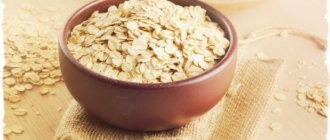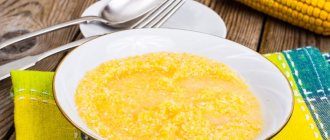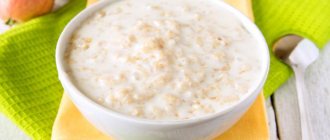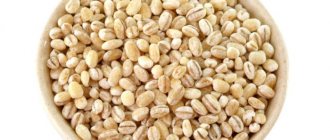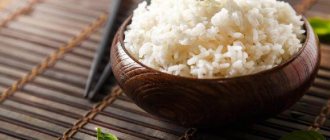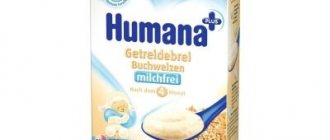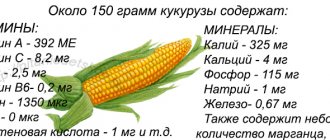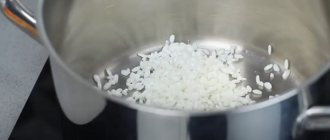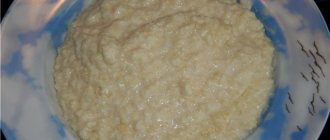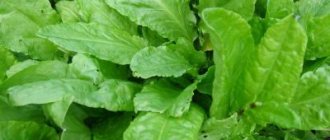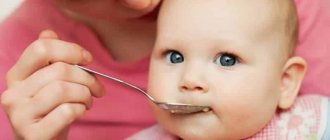Nutritionists recommend that healthy corn porridge be consumed by both children and adults, the elderly and weakened after illness. Mothers are interested in the benefits of corn porridge for the child’s body, at what age is it better to include it in the children’s menu, and how to properly prepare dishes for children from it.
The birthplace of corn is Central America, where the crop was grown 7 thousand years BC. e. The cereal was brought to Europe by Columbus, and it was first called “Indian wheat.”
Currently, countless varieties of this annual cultivated herbaceous plant are known; in Russia alone there are over 500 of them.
Different types of corn differ in stem height, ripening time, size, shape and color of grains, chemical composition, and taste. The color of the grains can be white, red, yellow, variegated.
Composition and calorie content
The nutritional value of corn grits is determined by its composition.
100 g of cereal contains:
- carbohydrates 71 g;
- proteins 8.3 g;
- fat 1.2 g;
- dietary fiber 4.8 g;
- water 14 g;
- ash 0.7 g.
Carbohydrates are represented almost entirely by starch and dextrins (69.6 g), and sugars are only 1.2 g. Fat includes saturated and unsaturated fatty acids.
Corn grits proteins:
- 10 essential amino acids (including arginine, valine, isoleucine, lysine, phenylalanine);
- 8 essential amino acids (alanine, glycine, aspartic acid, tyrosine, glutamic acid, cysteine, serine, proline).
The energy value of 100 g of corn grits is 328 kcal. In 1 tsp. ready-made porridge contains 39 kcal, 1 tbsp. l. – 98 kcal, in a 200-gram serving of milk porridge – 1443 kcal.
The vitamin composition of the cereal is very rich: PP, niacin, biotin (vitamin H), beta-carotene, vitamins gr. B (B1, B2, B5, B6, B9).
Corn grits contain minerals:
- macroelements – sodium, potassium, sulfur, phosphorus, magnesium, calcium;
- trace elements: copper, tin, iron, zinc, cobalt, chromium, manganese, molybdenum, aluminum, titanium, boron, nickel.
It is important that corn grits do not contain gluten (natural proteins that are part of many grains and contribute to the development of allergies). This makes corn a product safe for allergy sufferers.
Healthy recipes
The easiest way to prepare it is corn porridge in water without additives. It is suitable for babies 5-6 months old.
For this, 2 tbsp. The ground cereal should be poured with a glass of water and brought to a boil. Then the heat should be reduced and cooking continued for another 25-30 minutes, constantly stirring the porridge so that lumps do not form.
The finished mass must be transferred to a blender and crushed to a homogeneous consistency. When the baby turns one year old, you don’t have to grind the cereals, which significantly reduces the cooking time.
With added milk for babies 9-12 months
Preparation:
- take 2 tbsp. corn powder. Pour it into a deep container;
- add a little drinking water and mix the powder until a thick paste forms;
- In a separate bowl, heat about 1 tbsp. water and add corn paste. Knead thoroughly;
- cook the mixture for 10-15 minutes. Add formula or breast milk to adjust consistency;
- You can sweeten the dish with fruit pulp or sugar;
- butter should be added if the baby is already familiar with it.
With vegetable broth
Required:
- corn grits – 1 tbsp;
- carrots – 1 pc.;
- cabbage (or broccoli) – 100 g;
- potatoes - 1/2 tuber;
- water – 1 glass.
Wash the vegetables, finely chop them, pour boiling water over them and cook over low heat for about 20 minutes. Strain the resulting broth, squeeze out the vegetables, add the cereal and continue cooking. The porridge will turn out healthy and satisfying. For the decoction, you should take only proven vegetables to which the baby is not allergic. The first time this dish should be given to the baby in small portions. This porridge has a pleasant taste, so kids usually like it.
In a slow cooker
To prepare the dish you only need cereal and water in a ratio of 1:4. You can use the “Porridge” or “Rice” mode depending on the manufacturer of the device. The time will be set automatically. If the finished cereal is not cooked enough, it should be left to cook for another 20 minutes using the “Warming” mode. The porridge in the slow cooker turns out crumbly and aromatic.
Baked in the oven
To prepare it, take a clay pot with a thick bottom, pour 200 ml of water, add 2 tbsp. cereals The oven needs to be heated to 180 degrees, place a pot of porridge in it and leave to simmer for 20 minutes.
Then the porridge needs to be mixed and put in the oven for another 25 minutes. When the dish is ready, it should be left in the turned off oven for 20 minutes.
The porridge can be sweetened with pieces of fresh fruit or honey if the baby is not allergic.
Cereal decoction
For children with gastrointestinal problems, a decoction of corn grits will help, since it contains substances that slow down putrefactive processes in the intestines and remove toxins well. The decoction is prepared quickly. Bring 500 ml of water to a boil and add 50 g of corn grits to it.
Cooking time - 20 minutes. If necessary, add hot water, making sure that the cereal is covered. Leave for 10 minutes. Strain the resulting mixture through cheesecloth. The decoction is ready.
Infants are recommended to take 1 tsp before meals. twice a day. Recipes for preparing porridge for children under one year old do not mention butter, sugar or salt, those ingredients that are designed to improve the taste of the dish. Indeed, these products are not recommended for infants.
But if the baby categorically refuses complementary foods with an unsaturated taste, you can add a small amount of a specially prepared solution of salt or sugar to the dish. As for butter, it is recommended to include it in the baby’s diet, starting from the age of seven months, gradually increasing the norm from 1 to 4 grams per day.
Benefit
The rich composition of corn grits determines its beneficial effect on the child’s body.
Corn porridge is not only filling and tasty, but also healthy.
The impact of cereal nutrients is multifaceted:
- Pyridoxine (vitamin B6) takes part in the metabolic processes of proteins and fats, ensuring the functions of the central nervous system, maintaining the body's immune defense, promotes the formation of red blood cells, and normal heart function.
- Eating corn porridge promotes the normal development of the nervous system, prevents the development of neurological diseases, helps cope with depression, and improves sleep.
- Vitamin H is necessary for the synthesis of fats and the conversion of glucose into glycogen.
- Phosphorus is involved in metabolic processes and ensuring acid-base balance in the body. It is necessary for the synthesis of brain phospholipids and nucleic acids, ensuring the mineralization of bone tissue and tooth enamel. With a lack of phosphorus in the body, the child develops rickets and anemia.
- Vitamin B2 (riboflavin), biotin, zinc ensure healthy skin and nails, and hair growth.
- The antioxidant properties of vitamins E and A help tissue cells get rid of radionuclides and toxic substances.
- The product's fiber normalizes intestinal function and cleanses it of toxins. Eating corn porridge reduces the likelihood of fermentation and putrefactive processes. This reduces the likelihood of flatulence (bloating) and painful colic in babies, and makes bowel movements easier.
- Potassium, magnesium, pyridoxine ensure normal functioning of the cardiovascular system and correct heartbeat rhythm.
- Activation of metabolic processes, normalization of fat metabolism, and the cleansing functions of porridge lead to the removal of excess fat, prevent the development of obesity, and normalize cholesterol levels.
- Corn porridge is an excellent source of energy, has a general strengthening and immunostimulating effect, and helps recovery after illness.
- The quickly arising feeling of satiety when eating porridge prevents overeating, which is important for children with excess body weight.
The valuable properties of corn porridge make it possible to use it in the diet of children of all ages, including infants. The rich composition and easy digestibility of porridge make it possible not only to diversify a child’s menu, but also to improve his health.
The benefits of corn porridge for children
Corn porridge for first feeding is one of the components of a proper and balanced diet. The corn grain from which the product is made does not contain gluten, which means that allergies can be avoided without any problems. Well, the cereal itself is very healthy, because it is rich in vitamins.
Introducing corn porridge into a child’s diet will be beneficial because it:
- The rich vitamin composition and the presence of microelements allows the baby to fully grow and develop;
- Has a beneficial effect on the immune system – protects the body from infections, gently stimulating its defense reaction;
- Due to the content of unsaturated fatty acids in its composition, cereals protect the heart and blood vessels from the formation of blood clots and cleanse the blood;
- Contains a lot of fiber, which has a beneficial effect on the functioning of the gastrointestinal tract;
- Easily digestible, helps improve intestinal function, goes well with vegetables, meat and fish;
- The composition includes glutamic acid, which has a calming effect and helps promote sleep;
- Since corn porridge is low-calorie, it is well suited for overweight children.
It will not lose its beneficial properties even at high temperatures, and it can be prepared using various methods of thermal treatment - not only boiled or baked, but also steamed.
Possible harm
Although corn porridge requires a relatively long time (45-50 minutes) to prepare, it is easily absorbed in the child’s body.
There are no carcinogens or other harmful substances in it. Therefore, corn porridge can have a negative effect on the body only if it is consumed in excess - too often or in excess of the age norm of consumption.
- Overeating can cause in a child a violation of the acidity of gastric contents, indigestion, and a feeling of discomfort.
- A large amount of phosphorus in cereals, if the baby is fed corn porridge too often, can lead to the leaching of calcium from bone tissue, which will have a negative impact on the formation of the skeleton.
Why is corn porridge healthy?
In the first year of life, the baby grows very intensively, while simultaneously learning new skills and abilities. If up to six months breast milk or an adapted infant formula completely saturated the baby’s body with vitamins and nutrients, then after six months this is no longer enough, so doctors recommend introducing complementary foods. Which product will be first is decided only by a specialist, depending on the health and weight of the baby.
For children who are gaining weight well, it is recommended to start complementary feeding with vegetable purees at six months, and introduce porridge from seven months. But kids who cannot boast of curvy figures and are slightly behind in terms of average body weight are the first to try porridge.
Doctors often recommend starting complementary feeding with corn porridge.
On the recommendation of pediatricians and gastroenterologists, many parents introduce corn porridge to infants in their first year of life, the benefits of which are as follows:
- does not contain gluten, therefore it is considered a hypoallergenic product;
- is well absorbed in the child’s stomach;
- a balanced composition of vitamins and microelements contributes to the normal development of children;
- helps regulate the functioning of the digestive system, but at the same time it contains a lot of starch, so it strengthens. According to mothers, the dish has different effects on the baby’s stool;
- has a positive effect on the immune system: stimulates the body's defenses. Useful during the recovery period after illness and taking antibiotics;
- has a calming effect, because the composition contains glutamic acid, which stimulates metabolic processes in the central nervous system;
- protects blood vessels from the formation of blood clots, cleanses the blood, thereby having a beneficial effect on the functioning of the heart. These properties are due to the presence of unsaturated fatty acids in corn, which remove cholesterol and other waste from the body.
Corn grits do not lose their beneficial properties when exposed to high temperatures. It can be steamed, boiled or stewed. The result is a tasty dish with a large supply of substances necessary for the body.
But parents should know that in addition to the beneficial properties, corn grits also have negative aspects if consumed every day in large quantities:
- it is possible to increase the phosphorus content in the body and decrease calcium, which will harm the skeletal system and teeth;
- have a negative effect on the acid balance, so they are contraindicated for children who are registered with a gastroenterologist with problems of the gastrointestinal tract and duodenum.
In rare cases, some children experience fiber intolerance, so after eating corn porridge, they may experience indigestion, discomfort in the abdomen and intestines, nausea and even vomiting. In this case, you need to consult a doctor who will accurately determine the reason for the body’s reaction to the dish. If the diagnosis is confirmed, the doctor will select other products for feeding the baby.
Corn grits are rich in carbohydrates and proteins, and their calorie content is 371 kcal per 100 grams
Vitamin composition of different types of cereals - table
| Nutrients: vitamins and microelements (per 100 g of product) | Corn grits | Rice cereal | Buckwheat |
| Vitamin A, mcg | 10 | — | — |
| Vitamin B1, mg | 0,2 | 0,08 | 0,3 |
| Vitamin B3, mg | 1,7 | 3,3 | 6,2 |
| Folic acid, mg | 0,046 | 0,019 | 0,028 |
| Vitamin C, mg | 7 | — | — |
| Iron, mg | 0,5 | 1 | 8,3 |
| Magnesium, mg | 37 | 50 | 258 |
| Potassium, mg | 270 | 200 | 325 |
| Phosphorus, mg | 220 | 320 | 334 |
How and when to introduce it into a child’s diet
Experts recommend introducing corn grits porridge at the age of 8-9 months, when buckwheat and rice have already become familiar to the baby.
First, you should prepare porridge not from whole grains, but from corn flour. It is easy to prepare it yourself using a coffee grinder. This kind of porridge takes less time to cook - about half an hour.
For an infant under one year old, porridge should be prepared with water, without salt or sugar. You can add a little breast milk (or formula) to the finished porridge to get a familiar taste for your baby.
The first sample should be no more than 0.5-1 tsp. porridge, which is best given in the morning along with the main breakfast dish.
During the day, it is necessary to monitor the baby’s body’s reaction to new complementary foods. If there are no negative manifestations, the next day the portion of porridge is doubled.
Gradually the portion is brought to the age norm:
- 150 g at 9 months;
- 200 g per year.
Corn porridge should be on the menu no more than 1-2 times a week.
If after the first tests the baby develops negative symptoms (rash, abnormal stool, abdominal pain), then corn porridge is excluded from the diet for 1-2 years, repeated tests are agreed with the pediatrician.
Cereals should be thoroughly washed before cooking. To make the porridge lighter and cook faster, you can pre-soak it in cold water for 30 minutes. Cooked with milk, the porridge will be soft and crumbly.
You can cook porridge with milk (if the child can tolerate it) after 10-12 months. After a year, you can add a little butter or vegetable oil to the porridge. Adding a small amount of salt and sugar is only permissible for children after one year.
During infancy, corn porridge can be prepared:
- with vegetables;
- meat puree;
- fish (if tolerated).
Porridge should be prepared for the baby before each feeding. As a last resort, you can leave it in the refrigerator (up to a day) in a sealed container, and use a water bath to heat it before giving it to your baby.
You can use ready-made corn porridge. Before purchasing it, you need to carefully study the composition of the product and its expiration date. The composition should not contain:
- salt;
- Sahara;
- preservatives;
- rapeseed and coconut oils;
- flavorings.
It is better to consult with your pediatrician about using ready-made food.
There is no need to cook store-bought porridge. The required amount (according to the instructions) is diluted with boiled warm water (with the addition of breast milk).
Corn porridge can be prepared in a slow cooker:
- The washed cereal should be poured into the multicooker bowl and filled with water in a ratio of 1:3. First, the “Rice” mode is turned on, then the “Warming” mode for 30 minutes.
- For older children, the cereal is poured with milk, butter is added according to the recipe and the “Milk porridge” mode is turned on.
Corn porridge for infants as complementary food
Corn porridge is useful for small children - it is suitable for starting complementary feeding and helps regulate digestion. Even if a child is prone to allergies, children's corn porridge with goat's milk may be suitable for him. We analyze the plan for baby food with corn porridge by month together with the first category pediatrician Ekaterina Borisovna Bulavina.
— Ekaterina Borisovna, please tell us why porridge is introduced into children’s diets and is it possible to give children corn porridge?
— In the period from four to six months, the child begins to get acquainted with the first complementary foods. If the baby does not eat enough, is not gaining weight well, or suffers from functional disorders of the gastrointestinal tract, then porridge may be recommended as the first course of complementary feeding.
The child is one of the first to try corn porridge. It contains many useful substances that contribute to the development of a small organism, including the nervous system.
What are the benefits of corn porridge for children?
Gluten free
| An excellent source of energy, healthy fiber, nutrients
|
— How does children’s corn porridge differ from “adult” corn porridge?
— Corn porridge is made from corn flour, which is obtained by crushing dried corn grains. The grinding class and purpose of the cereal depend on the degree of crushing. Corn porridge for young children contains finely ground grains, while “adult” porridge contains coarser grains. It contains more fiber, but it will be difficult for infants to digest it, so it can be introduced into the children's diet only after a year.
Baby corn porridge (including milk) does not contain gluten protein, which allows it to be used as a first complementary food. This is its difference from gluten-containing oat and wheat porridges. The low allergenicity of corn grits makes it indispensable in the diet of allergy sufferers. Such porridge will be a source of slowly digestible carbohydrates and will create a feeling of satiety in the child for a long time.
Pediatricians recommend corn porridge for first feeding.
It is a low-allergenic, gluten-free product, easily digestible, and contains a sufficient amount of essential vitamins and microelements and healthy fiber. Does not promote rapid weight gain, satisfies hunger for a long time and gently regulates digestion.
— How does corn porridge affect a child’s stool? Can it lead to constipation and diarrhea?
— Like any other product, corn porridge can cause dyspeptic disorders in the form of changes in stool character, increased gas formation, and impaired gastrointestinal motility. But the appearance of these symptoms is often associated with the individual characteristics of a particular child or with incorrect methods of introducing complementary foods. In most cases, complementary feeding with corn porridge is well tolerated and helps normalize digestion.
Starting complementary feeding too early, large portions of corn porridge, or using coarse corn grits can lead to stool problems and abdominal pain in infants.
If, after eating porridge, the baby becomes restless, screams, or develops a rash on the skin or pathological inclusions in the stool (streaks of blood, an abundance of mucus, a strong odor), you should immediately consult a doctor to identify the cause.
- Corn porridge for children - at what age is it allowed and how to feed it correctly?
— Corn porridge should be administered to infants no earlier than four months. You should try with one or two teaspoons, gradually increasing the volume to the age norm over the course of a week:
- at 4 months - from 70 to 100 g;
- at 6 months - up to 150 g;
- by 8 months - up to 180-200 g.
Porridge, like any other type of complementary food, is offered to the baby before breastfeeding or formula feeding. To optimize the diet, it is recommended to feed corn porridge no more than two to three times a week.
— What to do if the child does not eat porridge?
— Kids are often capricious and refuse to try something new. Under no circumstances should you force feed a child. You should delay introducing the product for a couple of weeks and then try again.
If refusal of corn porridge is associated with changes in the baby’s condition - such as abdominal pain, colic, changes in stool, rash, then a longer pause should be taken: three to four weeks. Perhaps the children's enzyme system is not yet ready to absorb this product. If symptoms recur, you should consult a doctor to determine the cause of your digestive problems.
- Ekaterina Borisovna, there are several types of baby porridge made from corn flour - when and which one can you give to your child? From what months can you offer corn porridge with goat milk to children?
— Dairy-free corn porridge is more often used in the diet of children with allergies to cow's milk protein. Milk corn porridge is produced on the basis of both cow's and goat's milk. In my practice, I recommend using goat milk porridge.
Corn porridge with goat milk has a number of advantages:
- goat milk is easier to digest, forming a soft, curdled clot in the stomach;
- goat's milk is less allergenic, its fat component is close in structure to the fats of breast milk, therefore the tolerance of porridge with goat's milk is much better;
- Goat's milk porridge can be recommended for children whose family already has relatives with cow's milk protein intolerance, to minimize the risk of developing allergies.
As the baby grows, his appetite and interest in new foods grow. Corn porridge with vegetable or fruit additives is an excellent option to diversify the menu of any child. It will be especially useful for babies prone to constipation. Often a child refuses to eat vegetables or fruits in their pure form - then porridge with healthy additives is simply irreplaceable in his diet. Fruits and vegetables also provide dietary fiber, which is essential for good digestion. If they are deficient, the baby will suffer from constipation and an imbalance of intestinal microflora.
Goat milk porridges are approved for complementary feeding from five to six months. Prebiotics, natural vegetables, and fruits in their composition improve digestion.
— Is a ready-made version or a home-cooked dish more suitable as the first corn porridge?
- Instant cereals for complementary feeding
— In the production of porridges for feeding infants, corn grits of the finest grinding are used. It is almost impossible to prepare such cereals at home. Industrial porridges are additionally enriched with vitamins and microelements, while in “homemade” porridges they are destroyed when the cereal is cooked. This means that a baby who eats exclusively homemade cereals will not receive a number of essential nutrients necessary for full development.
Regular corn grits can be used in baby's nutrition after one year.
- Corn porridge recipe for children
— If mom decides to cook porridge at home, she will need to choose cereal from a trusted manufacturer, rinse it well, dry it, and grind it in a blender to the consistency of flour. The process of preparing porridge at home is quite labor-intensive; it requires about an hour of time every day to obtain a portion of one hundred to two hundred milliliters.
- Add crushed cereal to boiling water at the rate of 1 tsp. per 100 ml of water.
- The approximate cooking time is 20-30 minutes, the porridge must be stirred constantly.
- Instead of water, you can use cow's or goat's milk when diluted with water, first in a ratio of 1:8, then 1:4. Closer to two years, a 1:2 dilution is acceptable. It is recommended to use specialized milk for baby food.
Obviously, the use of industrially produced ready-made cereals is preferable. All you need to do is choose the brand that suits your baby. When choosing, you should pay attention to the manufacturer, the quality of the packaging, how detailed the composition is, and also compare the shelf life of the product and the production date. Porridges for baby food should not contain salt, sugar, preservatives, dyes, flavors, flavor enhancers and other spices, or foreign additives.
— You noted the benefits of corn porridge for the digestion of children under one year old. What attracts the attention of parents to our products?
— Corn porridge with prebiotics and goat milk MAMAKO® is an excellent source of energy for a growing body. It is more nutritious compared to dairy-free cereals, is easily digestible due to the unique properties of goat's milk, is non-allergenic and is suitable for feeding babies at risk of developing an allergy to cow's milk protein.
Other advantages of this porridge:
- corn phospholipids have a protective and anti-inflammatory effect on the baby’s delicate digestive system;
- the combination of soft dietary fibers from corn grits and goat's milk helps minimize the risk of developing functional disorders of the gastrointestinal tract, such as colic or constipation;
- for the full growth and development of the child, the cereal is enriched with B vitamins, fat-soluble vitamins A/ D/ E/ K, contains niacin, folic acid, biotin, minerals, as well as a calcium + iron + iodine complex for the prevention of rickets, iron deficiency and iodine deficiency;
- To diversify your diet and provide greater benefits, you can choose corn porridge with the addition of pumpkin and apricot. In addition, brightly colored vegetables and fruits are natural sources of beta-carotene, which is so necessary for good vision.
Corn porridge began to be used in the diet of children under one year of age relatively recently, but over the years it has gained increasing popularity. It is nutritious, low-allergenic, has a beneficial effect on the digestive process, and contains many useful vitamins and microelements. Corn porridge is allowed in the diet from four months onwards as a first complementary food. Dairy-free corn porridge is given to children with intolerance to cow's milk protein, and milk porridges are widely used in the diet of healthy children. Children at risk of developing allergies should be fed only dairy-free porridge or goat's milk-based porridge.
Pediatrician Ekaterina Borisovna Bulavina
*The ideal food for an infant is mother's milk. WHO recommends exclusive breastfeeding for the first 6 months. MAMAKO® supports this recommendation. Before introducing new foods into your baby’s diet, consult a specialist.
How to choose corn grits
The porridge prepared by mom is not only tastier, but also safer than an industrially produced product. The taste and quality of porridge depend on the correct choice of cereal.
You should buy premium quality cereals. The main selection criterion is color:
- The bright yellow color with pale small inclusions indicates that juicy varieties of dairy corn were used to make the cereal.
- Dull cereals are obtained when processing technology or storage conditions are violated. Dishes made from stale cereals will have a bitter taste, so you should not buy them in large quantities.
Varieties of corn grits are available for sale, depending on the processing method. As a result of crushing, polished grains of different calibers are obtained: No. 1 is the largest, and No. 5 is the smallest.
You can find steamed cereal in stores. It should be given preference, as its culinary properties are better:
- it is less rigid;
- boils faster.
At home, it is recommended to store corn grits in closed containers made of glass, metal, and ceramics. They are placed in a dark, dry place away from heat sources.
Recommendations for mothers
The first thing you need is to attract the baby with the appearance of the dish. The second is the taste, so that he likes the porridge and would always eat it with pleasure. Here are some cooking tips.
- Prepare porridge only from fresh cereals, so you will get the maximum benefit.
- Cook the porridge in a container with a thick or non-stick coating, this way you reduce the risk of spoiling the taste.
- Corn porridge can be either a sweet or savory dish.
- Corn porridge is usually introduced into the menu from the age of 9 months, after you have already introduced him to buckwheat and rice.
Coarse grains last longer; before preparing them for the children's menu, they can be ground again using a coffee grinder or food processor.
Corn porridge - a recipe for children under one year old
Ingredients
- 5 cups of cereal;
- 5 cups of water.
Cooking method
Pour the washed cereal into boiling water, stirring constantly, cook the porridge over low heat for 7 minutes. Then put in an oven preheated to 150 degrees for half an hour. Allow the finished porridge to cool slightly and blend it with a blender. You can add a little breast milk, for older children a teaspoon of butter per serving, a grated banana or apple.
Recipes for children
A child under one year old should cook porridge from corn flour.
Corn porridge for babies
It must be prepared from corn flour. You can buy ready-made flour, or you can make it yourself from corn grits (pre-washed and dried) using a coffee grinder.
Porridge made from flour is easier to digest and has no lumps. To prepare it, it is better to use cookware with a non-stick coating.
- The cereal, crushed to powder, should be carefully poured with hot water (at the rate of 2 tbsp per 125 ml).
- Cook for about half an hour with constant stirring and leave covered for a few minutes to brew.
Before feeding, you can add a small amount of breast milk to the porridge. To improve the taste, you can add banana and applesauce.
Milk corn porridge
This porridge is suitable for a child over one year old.
- To prepare, add 2 tbsp to a saucepan. l. washed cereal and pour in a glass of hot water.
- Cook while stirring for about 20 minutes over low heat.
- Then pour in a glass of hot boiled milk, add butter (20 g) and, continuing to stir, cook for another 15-20 minutes.
If desired, you can add a little sugar to the porridge or sweeten it with fruit. Suitable for this: 50 g of raisins, dried apricots, prunes.
Dried fruits should first be soaked in cold water for 30 minutes. The finished porridge is allowed to brew for several minutes (you can do it in a preheated oven).
Porridge with vegetables
To prepare this hearty porridge you should:
- peel 1 carrot and 200 g of broccoli, rinse and cook them;
- Cut half an onion and 300 g of pumpkin pulp and simmer for 5 minutes in vegetable oil;
- after removing the vegetables, add 200 g of washed corn grits into the resulting boiling broth, add onions and pumpkin and cook for half an hour;
- add carrots and broccoli and let the dish brew for 20 minutes;
- Grind the resulting dish using a blender;
- add vegetable oil (1 tsp) to the porridge.
Porridge with meat puree
This multi-component puree can be prepared for a baby from 10-11 months.
Cooking steps:
- cut 100 g chicken or beef fillet into pieces;
- cook meat without salt;
- 2 tbsp. l. corn flour, pour 100 ml of water and cook while stirring over low heat for about half an hour, let the dish brew;
- Combine the finished porridge with meat and grind in a blender;
- add vegetable oil (1 tsp).
How to cook corn porridge for a child
For little ones, corn porridge can be cooked in 10–15 minutes in a thick-bottomed ladle, since small grains are usually used. It is more difficult with a coarser product: it takes a long time to swell and stick to the walls of the pans. In order not to be tormented by questions about how long to cook a dish and how to wash burnt dishes, it is better to cook in a slow cooker.
Recipe for corn porridge for children on the water
For 4 parts water, take 1 part corn grits: for 2 cups of liquid you will need about 5 tbsp. l. product. Bring the water to a boil and pour in the corn in a stream. Cook over low heat for 15 minutes. Stir continuously with a spoon to prevent lumps from forming. When the mixture thickens, remove from heat.
The baby dish can be further pureed with an immersion blender. For older children, add salt, butter, raisins or fruit to the porridge. Can be served with vegetables.
Summary for parents
Corn porridge, which is beneficial for a growing body, can not only be a source of energy for an active, active child, but also provide him with minerals and vitamins and cleanse the body of toxins.
- Experts recommend using easily digestible porridge for complementary feeding to infants.
- Corn grits porridge can be combined not only with meat, vegetables, but also with fruits.
Properly prepared porridge can become one of the favorite dishes of older children. It will not create problems if you do not exceed the age norms for its consumption.
At what age can corn porridge be introduced into baby's complementary foods?
The most optimal age for a child to take the first test is about 7-9 months, taking into account individual weight gain parameters. However, it is worth considering that the baby should already be familiar with other types of grains, such as buckwheat, as well as vegetables. Sometimes, if a child cannot eat other cool foods, the doctor may allow him to start giving it earlier. The first few servings of the dish should be prepared without using milk or dry mixture. Like any other complementary food, start giving it to your baby with 0.5-1 teaspoon, and if the body reacts well, then you can continue to give it, increasing the portion each time. By the year the norm reaches 200 grams. Corn porridge with whole milk can be given to a child after he is one year old, and some doctors advise waiting until he is three years old. And before that, from one to three years, cook it in special baby milk. This porridge should be given no more than 1-2 times a week.
Delicious corn porridge with milk for a child in a pan
Corn porridge is included in the list of early complementary foods. Because of this, it can be prepared even for infants. I offer you such a simple recipe
Ingredients:
- 5 tablespoons corn grits (100 g)
- Sugar and salt to taste
- 200 g water
- Butter as desired
- 200 g milk
Preparation:
We start with the fact that the cereal needs to be washed very carefully. If necessary, we will first remove large debris from it. It is convenient to rinse in a sieve or in a regular bowl, changing the water.
Pour the washed corn into a saucepan and add water. At maximum power on the stove, bring it to a boil. As soon as this happens, pour milk, add salt and sweeten. We usually have one tablespoon of granulated sugar, a quarter of a teaspoon of salt.
Even if the porridge is planned to be sweet, it is better to add salt. It will highlight the sweetness well and add contrast. The saltiness will not be noticeable, but the taste will be noticeably better.
Stir with a spoon and wait until it boils again. Now the fire needs to be reduced to minimum
Interesting: Meatballs in sour cream sauce - delicious meatballs with gravy
Cook under these conditions for 10 minutes, stirring occasionally. Then turn off the stove, leave the porridge covered for about 5 minutes. Oil can be added immediately or when serving.
Delicious, healthy porridge is ready! You can have breakfast with it for adults and small children! Bon appetit!
How to select and store
Usually, polished corn grits are chosen for home use. It differs in numbers and, accordingly, in grind size. So there are the smallest grains No. 1 and 2, the larger ones - No. 3,4,5. You should not buy extra corn grits; usually old grits are bitter. Before purchasing, you should check the tightness of the packaging and the expiration date.
The grain should be uniform, without impurities, debris and mold, the grains should not be stuck together, the color of the corn grits should be yellow, but not very bright. It is necessary to store cereals in a dark, cool place, preferably in a glass or ceramic container, making sure it is sealed so that insects do not get inside the container where the cereal is stored.
It is best to use corn flour, which is ground from cereals, to prepare corn porridge for a child. It is better to grind cereals than to buy corn flour in the store, since the latter contains a large amount of starch, it is higher in calories, it lacks vitamin E and a small amount of B vitamins. Corn flour needs to be ground in a small amount, ideal for one time, but you can and two or three times. Store cornmeal in an airtight container in a dark, dry place.
Can corn porridge be harmful?
Corn porridge has very few contraindications as complementary food for infants. It is not recommended if the baby is diagnosed with pathologies of the digestive organs (in particular, the stomach and duodenum).
In addition, before introducing it into your child’s diet, you need to know about some features of this product:
- For children who are not gaining weight well, it is recommended to give porridge no more than once a week, and for those whose weight gain is within the normal range - 1-2 times a week;
- Phosphorus in corn cereals is useful only in certain dosages. When the body is oversaturated with this mineral, it binds to calcium and is washed out along with it, which over time negatively affects the development of the musculoskeletal system and the condition of the teeth;
- Excess sodium can cause nausea and dizziness in the baby, and over time even disturbances in the functioning of the cardiovascular system.
It is very important to correctly introduce corn porridge into complementary foods and follow the recommended norms for the child’s age. If it is consumed in excess, the baby's acid-base balance and water-salt metabolism are disrupted, and allergic reactions are possible.
Does corn porridge strengthen baby's stool?
Corn contains a lot of starch. This substance can slow down bowel movements and harden stools. In addition, for good peristalsis you need fiber, which is not enough in porridge, especially those made from premium grains.
Video recipe
Delicious corn porridge with milk promotes weight loss due to its low calorie content. It contains no fat and is enriched with minerals, proteins and carbohydrates. For those who want to get not only pleasure from food, but also benefits, today we will prepare such porridge.
Cereals are rich in fiber, and with the addition of sugar and oil, they are better absorbed and have a beneficial effect on the functioning of the gastrointestinal tract. Don't worry about the calorie content of the dish. A serving of the finished dish contains 115 kilocalories.
What types of cereals are there?
All types of grain products are a good source of carbohydrates, the content of which can reach 60-70%. At the same time, porridges contain a small amount of protein (7-13%) and fat (0.7-7%).
Although the content of basic nutrients (protein, fat and carbohydrates) in different types of cereals is approximately the same, different types of cereals and flour can differ significantly in the level of vitamins and mineral salts in them. Cereals also differ in the content of dietary fiber, which, in turn, influences the growth of beneficial microflora in the intestines, promotes regular bowel movements and the removal of toxic products from the body.
Buckwheat. It is a valuable source of B vitamins, magnesium and iron. Buckwheat contains 6-7 times more iron than rice or, for example, semolina. In addition, it is rich in zinc and copper. Contains a large amount of plant fiber (dietary fiber). Fiber is necessary for the normal functioning of the gastrointestinal tract. It stimulates intestinal motility, increases the volume and reduces the density of feces, helping to prevent constipation; has a positive effect on the growth of beneficial intestinal microflora. Being a sorbent, fiber helps remove harmful substances from the body. In addition, the high content of dietary fiber in buckwheat ensures a timely feeling of fullness, which prevents overeating and, as a consequence, obesity.
Oatmeal is a “champion” in calcium and phosphorus content.
Rice. It ranks first in carbohydrate content (mainly starch, which is very well absorbed by the child’s body). However, the content of healthy dietary fiber in rice cereal is lower than, for example, in buckwheat, oatmeal or millet.
Corn grits. This cereal is rich in starch and iron, vitamins B, E, A, PP, but the calcium and phosphorus content in it is not too high. A distinctive feature of corn porridge is its ability to inhibit fermentation processes in the intestines, reducing flatulence (bloating) and colic. Porridge made from corn grits usually requires a long cooking time, so in the past it was rarely used in feeding small children. However, modern instant corn porridges do not require long preparation and are easily digestible.
Oat groats. Contains a relatively large amount of vegetable protein. Rich in vitamins B1, B2, necessary for the normal functioning of the nervous system. Oatmeal is a “champion” in terms of calcium and phosphorus content, which are necessary for a growing body to form bone tissue and teeth. It contains a lot of magnesium and iron. Oatmeal contains the largest amount of vegetable (healthy) fats and is rich in fiber.
Millet. This cereal is obtained from millet grains. Millet is rich in protein and fiber, as well as B vitamins.
Pearl barley and barley cereals. They are obtained from crushed barley. If barley porridge is more suitable for children aged 1.5 - 2 years (its degree of grinding is higher), then pearl barley porridge is prepared for children over 3 years old. Pearl barley is whole barley grains, peeled and polished; barley grain is not polished, so it contains more fiber. In terms of the content of nutrients, these cereals are close to millet.
Semolina. It is made from wheat grains after they have been cleared of the upper layers (bran). (Wheat grits, semolina and flour are produced from wheat - they differ in the degree of grinding: wheat grits have the coarsest, flour has the finest). Semolina porridge has a high calorie content and is well absorbed by the child's body. That is why semolina has long been included in the list of basic products for baby food in our country. However, it is currently not recommended to offer semolina dishes to children under 1 year of age. At an older age, it is advisable to consume semolina in limited quantities. Such recommendations are due to the fact that semolina contains a large amount of the vegetable protein gluten, which determines its highly allergenic properties.
What is celiac disease? Celiac disease is a chronic hereditary disease in which eating grain products containing gluten leads to an inflammatory process in the intestinal mucosa, decreased absorption of nutrients, metabolic disorders, and hypovitaminosis (a condition characterized by a deficiency of certain vitamins in the body). The first signs of the disease appear more often in infancy after the start of introducing porridge into the baby’s diet and are characterized by weight loss, an increase in the size of the abdomen, and the appearance of loose, abundant foamy stools. Symptoms of the disease disappear fairly quickly when foods containing gluten are excluded from the diet. The final diagnosis is established only after a biopsy of the jejunal mucosa. The basis of treatment for this disease is a diet that excludes foods rich in gluten.
Semolina contains phytin in large quantities - a complex organic substance that binds calcium in the intestines, reducing its absorption by the child's body. Semolina porridge contains much less useful minerals than, for example, buckwheat and oatmeal. The predominance of this porridge over others in the diet can lead to excess weight due to its high calorie content. Semolina is poor in plant fibers, which, on the one hand, is a disadvantage. But on the other hand, thanks to this property, semolina porridge is indispensable in the nutrition of children who have undergone surgery on the abdominal organs (in the postoperative period), when therapeutic, chemically and physically gentle nutrition is prescribed (and fiber, as mentioned above, irritates the mucous membrane intestines and stimulates gastrointestinal motility).
Complementary feeding norms by month to one year
Most pediatricians recommend introducing corn porridge cooked with milk into a baby’s diet according to the following scheme:
- First, cook a very thin porridge: 5 g of cereal in half a glass of water. On the first day, give the baby 1 teaspoon of this porridge;
- If the child reacted well to the new product, then the next day the portion can be increased to 2 teaspoons.
- Within 7-10 days, increase the volume to 150 ml, completely replacing one feeding.
- After a week, you can cook thicker porridge (proportion – 10 g of cereal per half a glass of water). This porridge should be administered starting from 20-30 ml at a time.
- Over the course of a week, increase the portion to 150 ml.
Also, when introducing corn porridge with milk into complementary foods, it is very important for every mother to follow these rules:
- Porridge is given in the morning - this way it will be easier to digest, and the mother will have the opportunity to observe the baby’s reaction throughout the day;
- They feed the baby from a spoon, scooping a small amount of porridge into it;
- After the child eats the prescribed portion, he needs to be offered breast milk or an adapted formula.
How often to give
Infants who are not gaining weight well are given corn porridge with milk no more than once a week. For children whose weight gain is within normal limits, 1-2 times a week.
Note! Introducing corn porridge with milk into your baby’s diet will help provide the baby with nutrients important for development and growth.
Feeding baby porridge from a spoon
Quantity
The total volume of milk corn porridge eaten at one time should be as follows:
- For babies 7-8 months – 160-170 ml;
- For an 8-9 month old toddler – 170-180 ml;
- If the baby is older than 9 months - no more than 200 ml.
What can be combined with
If your baby is not allergic to bananas, they can be added to porridge, mashed in advance to a puree. You can also add a finely grated apple or pear. A good addition to the dish would be dried fruits: raisins, dried apricots, prunes.
Porridge with berries
